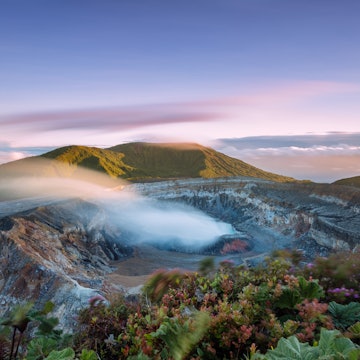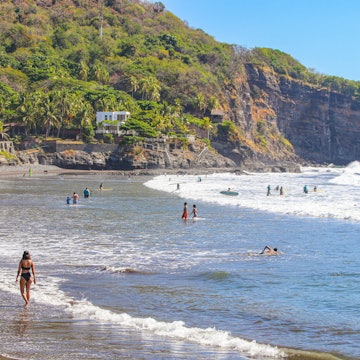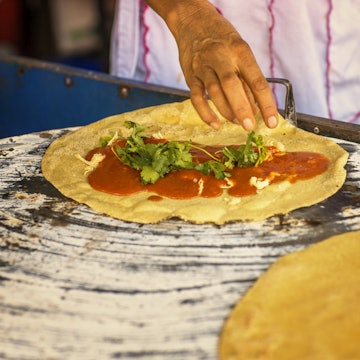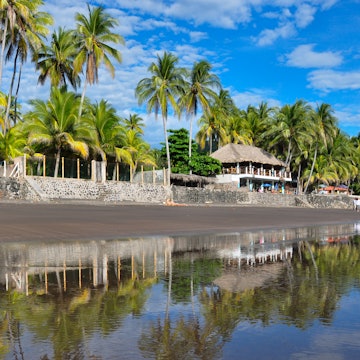
The 8 top things to do in San Salvador, El Salvador



The rainbow of stained glass in the Iglesia El Rosario in San Salvador. lingling7788/Shutterstock
Go back a few years, and people would have asked what you were thinking if you said you were going to San Salvador. The sprawling capital of El Salvador had an unenviable reputation, suffering first a violent civil war, then lingering problems with crime and gangs. But the city is turning a corner – tourism is rising, crime is falling and there’s a new spirit of optimism in the streets.
While many people still skip past El Salvador as they follow the overland trail through Central America, the country’s spectacular surf breaks, thrilling volcano trails and charming small towns are nudging onto the travel radar. Set close to some of the country’s best sights and surf hubs, San Salvador is emerging as a dynamic base for exploring the west of the country.
Recently, a wave of energy and investment has swept through San Salvador’s historic center, transforming it into a vibrant hub of culture, commerce and local life. Dilapidated buildings and abandoned spaces have been regenerated, important landmarks have been restored, and parks and plazas have been revitalized.
In the process, the city has started to shed its negative reputation. Many streets have been pedestrianized, and street lighting is creating an atmosphere of safety even after dark – a stark contrast to the days when venturing into the center at night seemed unthinkable.
To help you get more from your visit, here are the best things to do in San Salvador.

1. Explore in and around the Palacio Nacional
Like most Central American capitals, San Salvador is centered on a Spanish-era hub, laid out in a neat grid. At its heart is the Palacio Nacional, a majestic icon of Salvadoran history that has been restored to its former glory. Visitors can join a 20-minute guided tour to learn about its role in the nation’s story. Constructed in the early 20th century after the original building was destroyed by a fire, the palace is fronted by Plaza Barrios – a popular spot to promenade.
Adjacent to the Palacio Nacional, the neatly manicured Jardín Centroamérica was unveiled in 2024, creating a serene oasis amid the urban bustle. In the center, planted beds erupt with colorful blooms around a cascading water feature. Perhaps the most impressive addition to the historical center is the National Library (BINAES), a colossal, ultra-modern structure that is open 24/7 – a reminder of the power of urban renewal.
Planning tip: If you visit the National Library, consider dining at Basilico, a chic Italian restaurant on the 7th floor, for gourmet dishes and great views of the center.
2. Drop into the capital’s striking churches
El Salvador is fervently Catholic and the capital is dotted with must-see churches. Without knowing what lies behind its brutalist concrete facade, you could walk right past Iglesia El Rosario, but step inside and you’ll be bathed in jewel-colored light from its unique rainbow of stained-glass windows. Artist Rubén Martínez made this “Stairway to Heaven” in the early 1970s, creating a truly mesmerizing space.
Beyond the beautiful patterns that reflect onto the floor and walls, the cathedral bears the scars of a darker chapter in El Salvador’s story. In 1979, in the early days of the civil war, 21 protestors were killed here after seeking refuge in the chapel; bullet holes from the assault by government forces remain visible at the entrance.
While not as aesthetically impressive as El Rosario, the Catedral Metropolitana is a powerful symbol of resilience and reverence. On May 9, 1979, 24 demonstrators were shot by security forces on the front steps as the country descended into civil war. Later, the cathedral’s outspoken head, Archbishop Óscar Romero, was buried here after being assassinated in 1980, during one of his passionate speeches about human rights. Many locals come to pay their respects at his tomb in the cathedral’s underground crypt.
Planning tip: During the Semana Santa (Holy Week) celebrations in the run-up to Easter, vivid patterns known as alfombras are created in the streets of the capital using colored sawdust for religious processions to walk over, including around the Catedral Metropolitana.

3. Graze in San Salvador’s markets
San Salvador’s markets are some of the most vibrant and bustling in the country, reflecting the city’s mercantile spirit. San Salvador’s biggest is the Mercado Central, a short walk from the historic center. Inside this huge indoor market, decorated with floral graffiti, you’ll find vendors selling everything from puffy princess dresses to live poultry. Look out for kiosks selling imported US medicines sitting alongside stalls selling traditional herbal cures.
Right in the city center, the upstairs section of the Mercado Sagrado Corazón de Jesús overflows with stalls selling cheap imported dresses, T-shirts, printed tops and skirts in garish colors. Push past the fast fashion and you’ll emerge into a culinary Narnia – a dining section crammed with cozy comedores (simple local eateries) serving delicious meat stews and soups, fried fish, breaded chicken and salads.
Detour: For a more upmarket experience, take a taxi southwest outside the city to Mercado Municipal de Antiguo Cuscatlán (Mercadito de Merliot). It’s a favorite shopping stop for locals and the impressive food hall fills up at lunchtime with diners enjoying traditional Salvadoran dishes.
4. Admire ancient treasures and the arts at San Salvador's museums
While El Salvador was regarded as a backwater by the Spanish because of the lack of a Caribbean coastline, the territory was an important center for Mesoamerican culture, home to the Pipil people and several important hubs for the ancient Maya civilization. Treasures unearthed here, from ceramics to stone carvings, are displayed at the Museo Nacional de Antropología David J Guzmán, along with excellent displays on Mesoamerican history and culture.
At the top of the Zona Rosa district, next to the Teatro Presidente and the Monumento a La Revolución, the Museo de Arte de El Salvador is a dynamic space showcasing the best of Salvadoran creativity. If you haven’t previously encountered the art of El Salvador, the gallery will come as a pleasant surprise, with work exploring resonant themes such as colonialism, Indigenous heritage, civil war and gang crime.
Planning tip: If you're visiting with children, drop by the Tin Marin kids’ museum by Parque Cuscatlán; it’s full of interactive displays and there’s a dinosaur zone and a pretend grocery store.

5. Wander the city's upscale neighborhoods
In the west of San Salvador, you’ll find the Zona Rosa and Colonia Escalón districts, two of the most upmarket areas in the capital. Colonia Escalón is known for fine dining, high-end shopping and for housing the city’s elite. Take a wander from the Plaza Salvador del Mundo (formerly Plaza Las Américas), which is dominated by the imposing Monumento al Divino Salvador del Mundo, depicting Christ atop a globe – it was restored after being toppled from its perch by a major earthquake in 1986.
Over in the Colonia San Benito neighborhood, the Zona Rosa is a lively hub for culture and nightlife, and it’s where most tourists choose to base themselves. As you explore, look out for the sparkling skyscraper that houses the offices of Google – a powerful statement of growing international confidence in San Salvador’s progress and potential. This is also where you’ll find the excellent Museo de Arte de El Salvador and Museo Nacional de Antropología David J Guzmán.
Planning tip: Bulevar Del Hipodromo in Zona Rosa is lined with posh eateries such as La Gastroteca and Brutto. Alternatively, let your hair down with craft beers and bar food at Cadejo Brewing Company.
6. Soak in the greenery of the Jardín Botánico La Laguna
To escape the gridlocked traffic and urban sprawl of San Salvador, spend a quiet hour or so in the Jardín Botánico La Laguna, about 20 minutes from the center on the southwest side of the Antiguo Cuscatlán area. The garden is set in the crater of a volcano that last erupted around 2200 years ago, and the site was a working farm for generations before it was transformed into a botanical garden in 1912 by the Deininger Family.
Today, it’s a family-friendly oasis of trickling water features, dainty wooden bridges and stepping stones over lily-padded ponds. The further you walk into the leafy labyrinth, the more forest-like it feels, with paths winding through shadowy, overgrown walkways. The place is teeming with birds, turtles and cute rodents such as agoutis.
Planning tip: Get here on bus 44 from the city center; the Plan de la Laguna stop is about 1km from the garden.

7. Climb Volcán de San Salvador
The massif of the Volcán de San Salvador defines the capital’s skyline. Although the volcano is currently dormant, its last eruption in 1917 reshaped the landscape. Climbing to the top is a popular activity for hikers seeking a break from the city smog.
The volcano’s second-highest peak is El Boquerón (“the Big Mouth”), a 1.5km-wide crater set at 1800m, created by an eruption around 800 years ago. The crater forms part of Parque Nacional El Boquerón, a lush, green zone crossed by scenic hiking trails. Lookout points gaze down into the 500m-deep basin below, which is carpeted with dense vegetation. In the center is a smaller conical crater oxymoronically named El Boqueróncito (“the Little Big Mouth”).
Ambitious hikers can climb the volcano's highest peak, El Picacho, which rises to 1960m above sea level. The challenging ascent takes up to 3 hours, and the reward at the top is a dizzying panorama of San Salvador’s urban sprawl.
Planning tip: To reach El Boquerón by public transport, take bus 101B from San Salvador to Santa Tecla, then change to bus 103.
8. Follow La Ruta Panorámica
With a hire car or a car and driver, consider taking a morning or afternoon to follow La Ruta Panorámica, a road trip still fairly unknown among tourists but loved by locals. Dotted with food and drink pitstops, the road traces the south side of Lago Ilopango, the second-largest lake in the country, offering spectacular views of an expanse of heavenly blue water.
The best section of the route starts in Santiago Texacuangos, about 12km southeast of San Salvador, and ends 30km later in San Ramon in La Paz department. On the way back to San Salvador, take a detour to Los Planes de Renderos, which has a phenomenal lookout point and lots of popular food stands serving pupusas (stuffed corn griddle cakes).
Just south of the viewpoint is Parque Natural Puerta de Diablo, centered on a rock formation resembling two parted lips. Legend has it that the devil fled down this cleft after he was caught trying to seduce the daughter of a wealthy landowner.
Planning tip: Lago Ilopango is a popular destination for freshwater scuba divers; El Salvador Divers in San Salvador can arrange dive trips.
This article was adapted from Lonely Planet’s Central America guidebook, published in October 2025.












